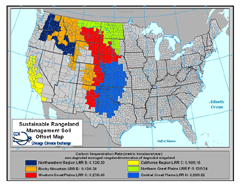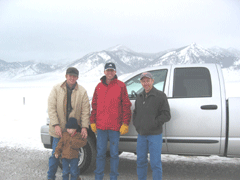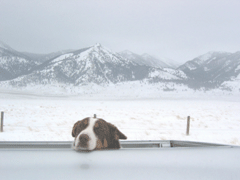Carbon Cowboys
Air Date: Week of March 7, 2008

Court Smith of Beartooth Capital, drives out to Sun Ranch in Cameron, Montana. (Photo: Ashley Ahearn)
Living on Earth’s Ashley Ahearn heads out to the Montana range to take a look at how ranchers are using their land to absorb the greenhouse gas carbon dioxide, and make some money on the carbon offset market in the process.
Transcript
CURWOOD: It’s Living on Earth. I’m Steve Curwood. The United States may have opted out of mandatory limits on global warming gases under the Kyoto Protocol, but there is a thriving market in credits for voluntary reductions of greenhouse gases. Much of it takes place at the Chicago Climate Exchange. Running a political campaign that’s racking up emissions from jetting around the country? That’s okay – brokers for the exchange can sell you carbon offsets, credits generated by operations that have reduced carbon emissions below the present norm. Many of these carbon credits come from collecting methane from landfills, planting trees or installing clean energy such as wind turbines. And now cattle ranchers are cashing in as well. Living on Earth’s Ashley Ahearn has our story from Cameron, Montana.
AHEARN: Court Smith and Todd Graham know what it’s like to feel a bit out of place. When they pull up at a ranch and tell the ranchers they pretty much want to pay them to boost the CO2 their land is already absorbing from the air - well, Smith says they’re usually just crossin’ their fingers they don’t get run out of the county.
SMITH: If it doesn’t sound like you’re sellin’ snake oil, I don’t know what else would be. You know, I got some air I wanna sell, and so it’s a very complicated system for your average person to grasp because it’s just so new.
AHEARN: As carbon brokers for a company called Beartooth Capital, they work with ranchers to increase the amount of CO2 the soil on their ranches absorbs. Then Smith and Graham sell credits for that CO2 on the Chicago Climate Exchange.

A regional map of CO2 absorption in the U.S. (Photo: Chicago Climate Exchange)
[CAR DOOR SLAMMING; DOGS BARKING; GATE OPENING]
AHEARN: Great weather today.
GRAHAM: Fairly typical, for January in the Madisons.
AHEARN: We’re about an hour and a half south of Bozeman, Montana, at the first and only ranch to sell credits to the Chicago Climate Exchange. Farm dogs bark and a couple of horses in the corral look up as we come through the gate.
It’s called Sun Ranch, but today, there’s a blizzard on.
WOMAN: C’mon in!
MAN: Hey!
STUART: My name is James Stuart and we are on the Sun Ranch in Cameron, Montana. Right now we’re down by Wolf Creek in my house.
STUART: This is Emma and this is Christian.
[LITTLE KID YELLING]
AHEARN: James Stuart manages Sun Ranch. Christian, his three-year-old, is all worked up because he’s coming out for a ride in the pick-up to show us what his daddy does.
[DOOR CLOSING, CAR STARTING]
AHEARN: As we drive up into the rangelands of Sun Ranch, James Stuart’s voice traces the land formations as he points through the windshield and drifting snow.
STUART: Alright, this is about the middle of the ranch. Our property will go up from the foothills a ways. We have Wolf Creek to the North, we have Moose Creek coming down out if this big canyon, and then…
AHEARN: The ranch covers about 26,000 acres of rolling range and the more grass grows, the more carbon gets pulled out of the air and stored in the soil. James Stuart now runs no more than 2,600 cattle, rotating them around the property throughout the year. He used to run twice that many. This ranch could afford that loss of income because the current owner came in with money to invest in making the ranch more sustainable.

Rancher James Stuart (left) and his son Christian (center left) take Todd Graham (center) and Court Smith (right) on a tour around Sun Ranch in the blizzard. (Photo: Ashley Ahearn)
BROWN: There is a lot of work that has to go into the documentation of the productive capacity of that land, the current condition that it’s in, the historical practices over the past and then some agreements on monitoring and the kind of adjustments they’ll make in response to changes in climate.
AHEARN: Brown is the guy the Climate Exchange went to when it first wanted to put a dollar value on CO2 in grasslands. And he told them not all grasslands are created equal.
BROWN: A very important part of carbon sequestration is climate, in particular, rainfall. That rainfall is what gets plants to produce. As those plants produce more biomass, more of it’s transferred below the ground and can be stored as carbon.

B the head farm dog enjoys a snowy ride in James Stuart's pick up. (Photo: Ashley Ahearn)
Brown and a team of scientists divided the country into regions and assigned a value to each one. The Sun Ranch falls in a region that absorbs .2 tons of CO2 per acre.
I asked Michael Walsh, Vice President of the Chicago Climate Exchange, to help me figure out how much money Sun Ranch gets for the carbon it absorbs every year.
AHEARN: So I did a little math, 26,000 acres times .2 that’s about 5,200 tons of CO2, so then, where do I go from here in terms of calculating that check?
WALSH: Well the 5,200 tons are currently worth approximately 20,000 dollars a year. They’re selling for about $4.25 a ton and you convert the tonnage into sales price and your check comes after you execute the sale.
AHEARN: 20,000 bucks, 5,200 tons. To the Climate Exchange, that’s peanuts.
WALSH: Now that said, it may be a small piece of the solution set, but it can be a significant opportunity for the landowner that undertakes these best management practices.
AHEARN: Sun Ranch got a check that about equaled a quarter of its annual income. And that wasn’t peanuts to James Stuart.
[TRUCK SOUNDS]
STUART: It’s an extra bonus that’s needed for many agriculturists that are spending their lives and working hard, putting their sweat on the land.

A blizzard on Sun Ranch in Montana's Madison Range. (Photo: Ashley Ahearn)
STUART: Our average age of our agriculturists are, it’s above 60 in the United States, and so we really need to work on encouraging youth to get back into agriculture.
AHEARN: The Stuarts have worked hard to raise their kids to love ranching. So far three-year-old Christian Stuart seems pretty happy helping Dad out on the range – even if it’s just by shifting gears in the pick-up.
STUART: Okay, shift for me…There you go.
[CAR ACCELERATES]
STUART: Tell ‘em all the stuff that you’ve seen on this ranch. What are the wildlife that you’ve seen?
CHRISTIAN: One mommy and two babies.
STUART: Mommy and baby what?
CHRISTIAN: Bears.
STUART: Oh bears, what else have you seen?
CHRISTIAN: And I’ve seen a wolf, one daddy wolf and I’ve seen a badger and a baby antelope. I’ve seen a bunch of daddy deer.
STUART: But how do you know if it’s a dad?
CHRISTIAN: Because. I just tell them when I saw one.
STUART: What does it have?
CHRISTIAN: Horns and stuff.
STUART: (laughing) Horns and stuff.
AHEARN: Christian just got his first pony for Christmas, because mom got tired of having a back-seat rider when the family was out herding cattle. He’s a paint gelding Christian Stuart named Paint.
The new rangelands program may never get off the ground, depending on federal carbon policy. But if it does, it could give Christian Stuart, and other young ranchers, the chance to have back-seat riders of their own someday.
For Living on Earth, I’m Ashley Ahearn in Cameron, Montana.
Links
Living on Earth wants to hear from you!
Living on Earth
62 Calef Highway, Suite 212
Lee, NH 03861
Telephone: 617-287-4121
E-mail: comments@loe.org
Newsletter [Click here]
Donate to Living on Earth!
Living on Earth is an independent media program and relies entirely on contributions from listeners and institutions supporting public service. Please donate now to preserve an independent environmental voice.
NewsletterLiving on Earth offers a weekly delivery of the show's rundown to your mailbox. Sign up for our newsletter today!
 Sailors For The Sea: Be the change you want to sea.
Sailors For The Sea: Be the change you want to sea.
 The Grantham Foundation for the Protection of the Environment: Committed to protecting and improving the health of the global environment.
The Grantham Foundation for the Protection of the Environment: Committed to protecting and improving the health of the global environment.
 Contribute to Living on Earth and receive, as our gift to you, an archival print of one of Mark Seth Lender's extraordinary wildlife photographs. Follow the link to see Mark's current collection of photographs.
Contribute to Living on Earth and receive, as our gift to you, an archival print of one of Mark Seth Lender's extraordinary wildlife photographs. Follow the link to see Mark's current collection of photographs.
 Buy a signed copy of Mark Seth Lender's book Smeagull the Seagull & support Living on Earth
Buy a signed copy of Mark Seth Lender's book Smeagull the Seagull & support Living on Earth

